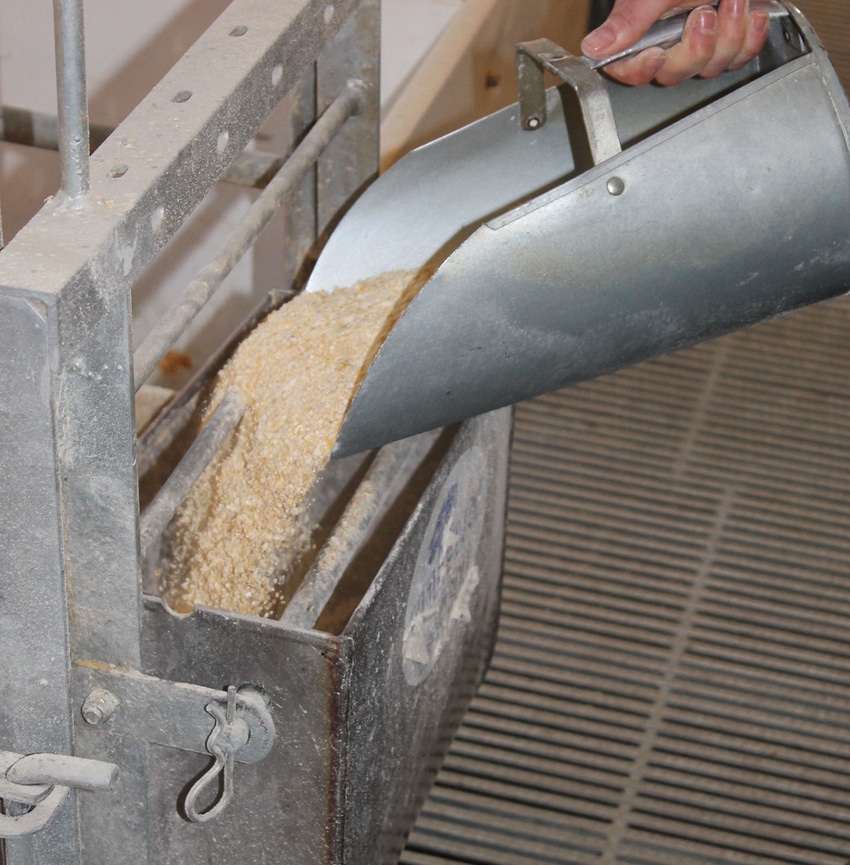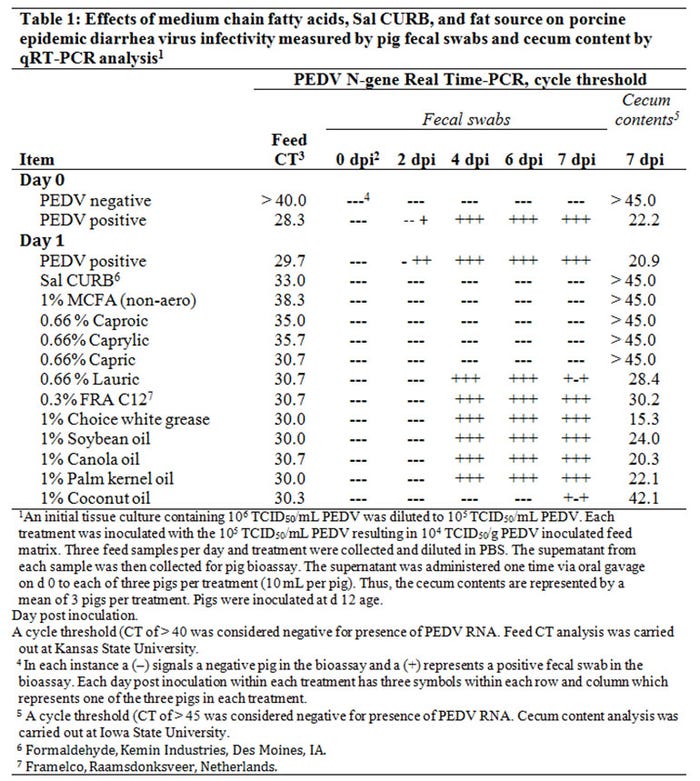MCFAs were equally as successful at mitigating PEDV in a swine diet as a commercially available formaldehyde product and as individual fatty acids.
February 16, 2017

By Roger Cochrane, Steve Dritz, Jason Woodworth, A.R. Huss, Charles Stark, Marut Saensukjaroenphon, Jordan Gebhardt, Joel DeRouchey, Mike Tokach, Bob Goodband, J. Bia and Cassie Jones, Kansas State University; and Qi Chen, Jianqiang Zhang, Phillip Charles Gauger, Rachel J. Derscheid, Rodger Main, Iowa State University
Research has confirmed that chemical treatments, such as medium chain fatty acids and commercial formaldehyde, can be effective to reduce the risk of porcine epidemic diarrhea virus cross-contamination in feed. Epidemiological and controlled experiments have shown that complete feed or feed components can be one of many possible vectors of transmission of PEDV (Dee et al., 2014).
Previous research has shown that a 2% and 1% mixture of caproic, caprylic and capric acids, and a commercially available formaldehyde can reduce the risk of PEDV in a complete swine diet (Cochrane et al., 2016). However, it has not been established if the response observed from the medium chain fatty acid treatment is due to unique characteristics of those particular fatty acids, or if the response is due to increasing the total quantity of fat in the diet. Furthermore, the synthetic blend of medium chain fatty acid previously tested is not commercially available and may be cost-prohibitive to employ, so further evaluation of the mode-of-action of MCFA and potential replacement with commercially available sources is warranted.
Therefore, the objective of this study is to compare the efficacy of commercially available sources of MCFA and other fat sources versus a synthetic custom blend of MCFA to minimize the risk of PEDV cross-contamination as measured by quantitative reverse transcription polymerase chain reaction and bioassay.
Seventeen different treatments were tested on their ability to reduce PEDV in feed. The treatments ranged from combinations of medium chain fatty acids, individual fatty acids, different fat sources, commercial formaldehyde, positive control (no treatment with the addition of PEDV), and a negative control (no treatment or PEDV). Each treatment was evaluated for the reduction of PEDV over four analysis days of 0, 1, 3, and 7 post-inoculation.
Matrices were first chemically treated, then inoculated with PEDV, stored at room temperature until being analyzed by qRT-PCR in order to see if each treatment would reduce the amount of PEDV. The feed was first chemically treated in order to evaluate the treatments as a potential way to reduce cross-contamination of feed and ingredients.
The analyzed values represent threshold cycle, at which a higher CT value represents less detectable RNA or less detectable virus. The results indicated that over time, feed treated with MCFA treatments, either as a mixture (aerosolized and non-aerosolized), or as individual fatty acids (caproic, caprylic and capric), and Sal CURB, had less detectable PEDV RNA compared to the positive control. Day also had a significant impact on the amount of viral RNA present, as the amount of detectable RNA decreased from day 0 to 7, respectively.
Based on the CT values obtained from the study, the treatments listed in Table 1 were used to look at infectivity in a swine bioassay or to see if the treatments could keep pigs from becoming infected one day after inoculation. As expected, Sal CURB resulted in a negative bioassay along with 1% MCFA mixture, 0.66% caproic, 0.66% caprylic and 0.66% capric acids (Table 1). In both instances the PEDV positive treatments at Days 0 and 1 both resulted in positive bioassays along with each of the other Day 1 treatments. However, it is important to point out that the coconut oil treatment was not deemed positive until the last day of the bioassay.

In summary, time, Sal CURB, 1% MCFA, 0.66% caproic, 0.66% caprylic and 0.66% capric acids enhance the RNA degradation of PEDV in swine feed. These treatments also led to a negative bioassay in the pigs showing that the treatments prevented infection. Notably, the medium chain fatty acids were equally as successful at mitigating PEDV as a commercially available formaldehyde product in the complete swine diet at 1% inclusion and as individual fatty acids.
This full article can be found online.
References
Dee et al., 2014. An evaluation of contaminated complete feed as a vehicle for porcine epidemic diarrhea virus infection of naïve pigs following consumption via natural feeding behavior: proof of concept. BMC Veterinary Research 2014, 10:176.
Cochrane et al., 2016. Evaluating the inclusion level of medium chain fatty acids to reduce the risk of PEDV in feed and spray-dried animal plasma. Journal of Animal Science 94.supplement2 (2016): 50-50.
You May Also Like



